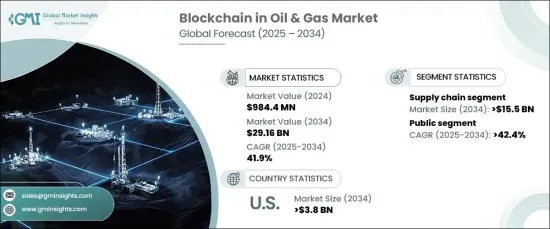
|
市場調査レポート
商品コード
1664868
石油・ガスにおけるブロックチェーンの市場機会、成長促進要因、産業動向分析、2025年~2034年予測Blockchain in Oil and Gas Market Opportunity, Growth Drivers, Industry Trend Analysis, and Forecast 2025 - 2034 |
||||||
カスタマイズ可能
|
|||||||
| 石油・ガスにおけるブロックチェーンの市場機会、成長促進要因、産業動向分析、2025年~2034年予測 |
|
出版日: 2024年12月03日
発行: Global Market Insights Inc.
ページ情報: 英文 50 Pages
納期: 2~3営業日
|
全表示
- 概要
- 目次
石油・ガスにおけるブロックチェーンの世界市場は、2024年に9億8,440万米ドルとなり、2025年から2034年の間に41.9%の著しいCAGRで急増すると予測されています。
分散型デジタル台帳システムであるブロックチェーン技術は、安全で改ざん防止された取引記録を提供することで、石油・ガス分野に革命をもたらしています。この最先端技術は、比類のない透明性と業務効率を要求する業界のゲームチェンジャーとして台頭しています。

石油・ガス業界はますます複雑化しており、ブロックチェーンのような革新的なソリューションの必要性が高まっています。取引を自動化し、プロセスを合理化することで、ブロックチェーンは手作業による事務処理への依存を大幅に減らし、遅延、エラー、不正を削減します。こうした利点から、ブロックチェーンは、サプライチェーン全体の効率を高めながら、資源・資材管理を最適化するための不可欠なツールとして位置付けられています。
| 市場範囲 | |
|---|---|
| 開始年 | 2024年 |
| 予測年 | 2025年~2034年 |
| 開始金額 | 9億8,440万米ドル |
| 予測金額 | 291億6,000万米ドル |
| CAGR | 41.9% |
ブロックチェーン技術は、サプライチェーン管理、オペレーション、取引、セキュリティなど、石油・ガスのバリューチェーン全体で多様な用途を見出しています。特にサプライチェーン分野は、2034年までに155億米ドルを生み出すと予測され、支配的な地位を占めるとみられています。利害関係者間でのリアルタイムのデータ共有の必要性が、この成長の主な原動力となっています。ブロックチェーンが可能にする複数地域にまたがる材料や製品の追跡により、企業は在庫管理と予測精度を高めることができ、業界変革の要となります。
市場はパブリックブロックチェーンソリューションとプライベートブロックチェーンソリューションに分類されます。パブリックブロックチェーンは、2034年までのCAGRが42.4%と驚異的な伸びを示すと予測されています。政府や公的機関は、その透明性と資源管理における腐敗と闘う能力から、パブリックブロックチェーンをますます支持するようになっています。さらに、持続可能な慣行と環境規制の遵守が重視されるようになっていることも、パブリックブロックチェーンソリューションの採用をさらに後押ししています。
米国では、石油・ガスにおけるブロックチェーン市場は2034年までに38億米ドルに達すると予測されています。規制の監視、投資家の要求、国民の期待の高まりが、透明で不変の記録管理システムの必要性を高めています。ブロックチェーン技術は、採掘から最終的な流通まで、サプライチェーン全体のアカウンタビリティを保証します。さらに、厳しい環境規制や安全規制、財務情報開示要件がブロックチェーンの採用を加速させています。非公開会社と政府機関の共同パイロットプロジェクトは、米国での市場拡大をさらに後押しします。
目次
第1章 調査手法と調査範囲
- 市場の定義
- 基本推定と計算
- 予測計算
- 一次調査と検証
- 一次ソース
- データマイニングソース
- 市場の定義
第2章 エグゼクティブサマリー
第3章 業界洞察
- 業界エコシステム
- 規制状況
- 業界への影響要因
- 成長促進要因
- 業界の潜在的リスク・課題
- 成長可能性分析
- ポーター分析
- 供給企業の交渉力
- 買い手の交渉力
- 新規参入業者の脅威
- 代替品の脅威
- PESTEL分析
第4章 競争情勢
- イントロダクション
- 戦略ダッシュボード
- イノベーションとテクノロジーの展望
第5章 市場規模・予測:カテゴリー別、2021年~2034年
- 主要動向
- パブリック
- プライベート
第6章 市場規模・予測:用途別、2021年~2034年
- 主要動向
- サプライチェーン
- オペレーション
- トレーディング
- セキュリティ
第7章 市場規模・予測:地域別、2021年~2034年
- 主要動向
- 北米
- 米国
- カナダ
- メキシコ
- 欧州
- ドイツ
- 英国
- オランダ
- フランス
- スペイン
- アジア太平洋
- 中国
- 日本
- シンガポール
- オーストラリア
- 中東・アフリカ
- サウジアラビア
- アラブ首長国連邦
- 南アフリカ
- ラテンアメリカ
- ブラジル
- チリ
第8章 企業プロファイル
- Accenture
- ConsenSys
- Hindustan Petroleum
- IBM
- Infosys Limited
- Kaleido
- Neoflow
- SAP
- VAKT Global
- VeChain
- Zupple Labs
The Global Blockchain In Oil And Gas Market, valued at USD 984.4 million in 2024, is projected to surge at a remarkable CAGR of 41.9% between 2025 and 2034. Blockchain technology, a decentralized digital ledger system, is revolutionizing the oil and gas sector by providing secure, tamper-proof transaction recording. This cutting-edge technology is emerging as a game-changer for an industry that demands unparalleled transparency and operational efficiency.

The oil and gas industry is becoming increasingly complex, driving the need for innovative solutions like blockchain. By automating transactions and streamlining processes, blockchain significantly reduces the reliance on manual paperwork, cutting down delays, errors, and fraud. These advantages position blockchain as an indispensable tool for optimizing resource and material management while enhancing overall supply chain efficiency.
| Market Scope | |
|---|---|
| Start Year | 2024 |
| Forecast Year | 2025-2034 |
| Start Value | $984.4 Million |
| Forecast Value | $29.16 Billion |
| CAGR | 41.9% |
Blockchain technology finds diverse applications across the oil and gas value chain, including supply chain management, operations, trading, and security. The supply chain segment, in particular, is poised to dominate, projected to generate USD 15.5 billion by 2034. The need for real-time data sharing among stakeholders is a primary driver of this growth. With blockchain-enabled tracking of materials and products across multiple regions, companies can enhance inventory management and forecasting accuracy, making it a cornerstone of industry transformation.
The market is categorized into public and private blockchain solutions. Public blockchains are anticipated to experience an impressive CAGR of 42.4% through 2034. Governments and public agencies increasingly favor public blockchains for their transparency and ability to combat corruption in resource management. Moreover, the rising emphasis on sustainable practices and compliance with environmental regulations further bolsters the adoption of public blockchain solutions.
In the United States, the blockchain in oil & gas market is forecast to reach USD 3.8 billion by 2034. Growing regulatory scrutiny, investor demands, and public expectations are driving the need for transparent and immutable record-keeping systems. Blockchain technology ensures accountability across the supply chain, from extraction to final distribution. Additionally, stringent environmental and safety regulations, along with financial disclosure requirements, are accelerating blockchain adoption. Collaborative pilot projects between private companies and government bodies further fuel market expansion in the U.S.
Table of Contents
Chapter 1 Methodology & Scope
- 1.1 Market definitions
- 1.2 Base estimates & calculations
- 1.3 Forecast calculation
- 1.4 Primary research & validation
- 1.4.1 Primary sources
- 1.4.2 Data mining sources
- 1.5 Market Definitions
Chapter 2 Executive Summary
- 2.1 Industry synopsis, 2021 – 2034
Chapter 3 Industry Insights
- 3.1 Industry ecosystem
- 3.2 Regulatory landscape
- 3.3 Industry impact forces
- 3.3.1 Growth drivers
- 3.3.2 Industry pitfalls & challenges
- 3.4 Growth potential analysis
- 3.5 Porter's analysis
- 3.5.1 Bargaining power of suppliers
- 3.5.2 Bargaining power of buyers
- 3.5.3 Threat of new entrants
- 3.5.4 Threat of substitutes
- 3.6 PESTEL analysis
Chapter 4 Competitive landscape, 2024
- 4.1 Introduction
- 4.2 Strategic dashboard
- 4.3 Innovation & technology landscape
Chapter 5 Market Size and Forecast, By Category, 2021 – 2034 (USD Million)
- 5.1 Key trends
- 5.2 Public
- 5.3 Private
Chapter 6 Market Size and Forecast, By Application, 2021 – 2034 (USD Million)
- 6.1 Key trends
- 6.2 Supply chain
- 6.3 Operations
- 6.4 Trading
- 6.5 Security
Chapter 7 Market Size and Forecast, By Region, 2021 – 2034 (USD Million)
- 7.1 Key trends
- 7.2 North America
- 7.2.1 U.S.
- 7.2.2 Canada
- 7.2.3 Mexico
- 7.3 Europe
- 7.3.1 Germany
- 7.3.2 UK
- 7.3.3 Netherlands
- 7.3.4 France
- 7.3.5 Spain
- 7.4 Asia Pacific
- 7.4.1 China
- 7.4.2 Japan
- 7.4.3 Singapore
- 7.4.4 Australia
- 7.5 Middle East & Africa
- 7.5.1 Saudi Arabia
- 7.5.2 UAE
- 7.5.3 South Africa
- 7.6 Latin America
- 7.6.1 Brazil
- 7.6.2 Chile
Chapter 8 Company Profiles
- 8.1 Accenture
- 8.2 ConsenSys
- 8.3 Hindustan Petroleum
- 8.4 IBM
- 8.5 Infosys Limited
- 8.6 Kaleido
- 8.7 Neoflow
- 8.8 SAP
- 8.9 VAKT Global
- 8.10 VeChain
- 8.11 Zupple Labs

